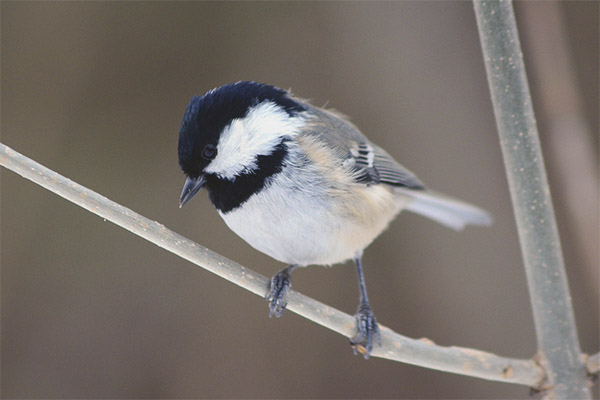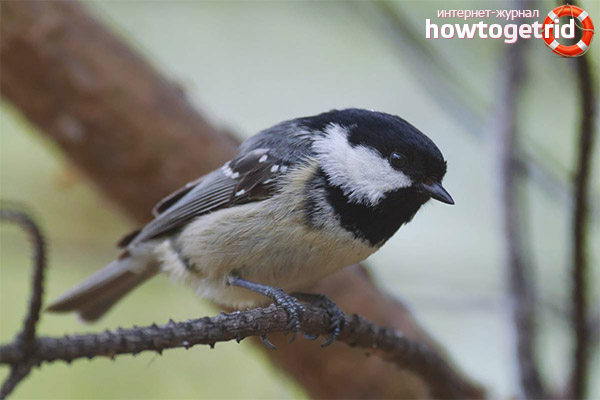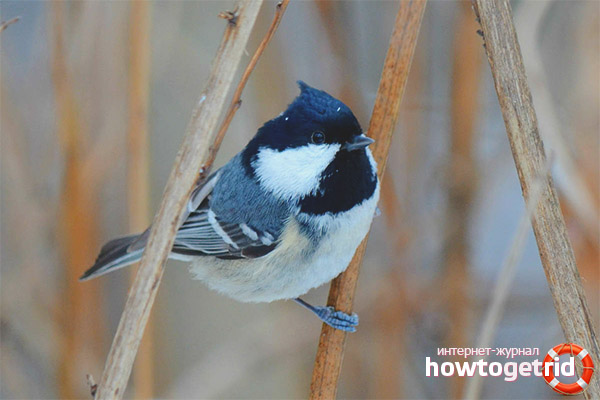The content of the article
Moscovka is a small species of mobile birds of the Blue Tit family. Previously, it was called “masked” because of the black color of the head, but then the name changed slightly to the modern version.
Appearance
By itself, a bird of small size - 10-15 cm, weighing up to 12 grams. The appearance of the male and female is practically the same, it is rather fidgety, mobile, small in size with a short tail. Females are a little faded in comparison with males. The bird has a black color of the head, under a beak above a breast - the black speck similar to a tie. Below it is gray-white in color, at the top is gray-blue with ocher sides. The tail and wings are also grayish-brown.
Feathers on the head are slightly elongated, resembling a crest - only in birds of the southern subspecies.
She sings from March to September, likes to make sounds, humming them on one note, sitting on the treetops, which have a full overview around.
Habitats
In the European part of the Russian Federation, it can live at a level of 65 degrees north latitude, and in the valley of the Ob river - 64 degrees c. sh.
She leads an established lifestyle, but if she is sorely lacking food, she can change her place of residence. Many trowels arrive on arrival of a warm pore, while others remain to occupy a new place.
In the mountainous part it moves vertically from valleys to places covered with snow of smaller thickness. Dwells mainly in high-coniferous forests, giving preference to spruce forests. It also occurs in the southern part of Kamchatka, in the Ukraine, the Altai, the southern Urals, the upper part of the Amur River, as well as in Turkey, Sakhalin, Corsica, and Taiwan.
Way of life
This genus of birds lives in flocks, only in the mating season can it live with its half until the chicks grow. A flock of up to 50 individuals, but in some parts of Siberia can reach hundreds and even thousands of individuals.As a rule, it includes not only tits, but also other types of tits, as well as chiffchades, blood beetles and common pikas.
Lives, as a rule, in the cracks of the mountains, the abandoned minks of rodents, old stumps and hollows of trees, especially prefers abandoned hollows of woodpeckers. The house is woven from sticks, feathers, horsehair, from the inside it is lined with cobwebs and wool, the male does not participate in building the nest, but it remains his duty to feed the “spouse” as soon as the chicks are born.
Upon reaching one year old, the bird begins to have a sexual life: a one-year-old fixture finds a partner and, as a rule, remains loyal to him. There are cases when, due to lack of food, a bird even shares food with its half, so as not to be separated for a long time.
During the search for the half, the bird develops a hunting appetite. She hunts for beetles, butterflies, flies, dragonflies, aphids, grasshoppers, worms and other insects that suit her taste. In the summer, her diet is more varied; this is connected not only with the abundance of food, but also with the love of the bird for food.
Upon the arrival of autumn and winter, the diet of the bird changes dramatically. Its nutrition includes the seeds of conifers.An important support in the winter for her are the feeders, bread crumbs, seeds and grain that people leave for them.
Mating season
The marriage period at tits lasts from the end of March to the end of June. The male seduces the female with his singing, dancing and shaking his wings, publishes melodious trills.
After the birds have found their half, they proceed to the construction of the nest, which, as mentioned above, is occupied by the female.
During the laying period for the season, the tusk can lay down from 5 to 9 eggs. Moskovka performs two masonry for the period, it happens almost always and in all its habitats, with the exception of some regions of Africa. The eggs are white and small in size with small brown or reddish spots.
Chicks grow an average of 20 - 25 days. During this time, the male feeds, especially the first few days. The female at this time is with chicks, protecting and warming them. As soon as the chicks have gotten a little stronger, the mother also goes in search of food. Reaching a month of age, the chicks live with their parents for a couple of days, and then go to free flight.
In the fall, they join the flock, before the onset of spring, while trying to keep up with adults and be as close as possible to those close to them.
Interesting Facts
- Moskva has more than 20 subspecies, which practically do not differ among themselves.
- Like all titmouse, it is very voracious and eats throughout the day. Even when one does not want to eat, she hides her food in the nest or hollows, in order to eat it later.
- Easily tamed, after two weeks she can eat from the hand of a person.
- It has an excellent memory and can remember the places where it previously found food to return to it.
- The average lifespan of a trowel is 9 years.
- Her heart carries about 1,200 cuts per minute.
- In summer, it eats 300-400 caterpillars, i.e. per day can eat as much food as she weighs.
- They do not owe their name to the Moscow region, they were previously called “masked” because of the black “cap” and tie on the chest, then the name was transformed.
- Moscovka - the only kind of blue-headed people who do not live in a cage. She quickly gets used to the person, especially if you behave with her carefully and without sudden movements.
- She has no particularly amazing appearance, but has an excellent musical talent, which makes admire her wonderful voice.
Video: T-shirt (Periparus ater)













To send